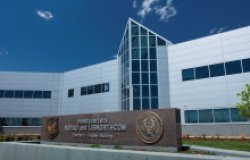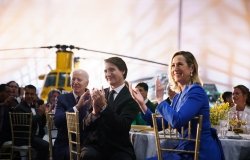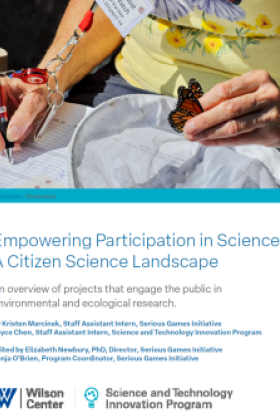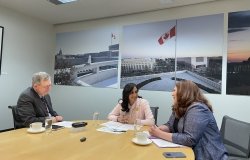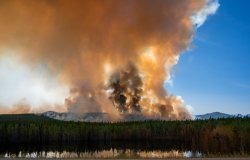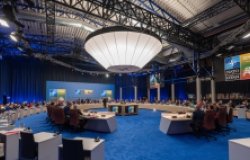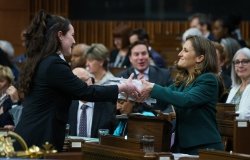Educate to Innovate: Improving Education Standards
"Educate to Innovate" is the name of President Barack Obama's campaign to encourage education in science, technology, engineering, and mathematics. These four subjects, or STEM, define much of the work of the Wilson Center's Program on America and the Global Economy (PAGE). And thanks to a grant from the Carroll and Milton Petrie Foundation, the Program has launched an effort focused on STEM education in America's K-12 education system.
PAGE began this endeavor by exploring the role business is playing in improving mathematics and science education for minorities and women in today's schools. PAGE recently broadened its focus to include teacher preparation, the question of national standards, and the successes achieved by school systems in the United States and in other advanced economies.
PAGE is also seeking to learn from education experiments taking place in such cities as New Orleans and Washington, D.C. As New Orleans continues to rebuild its infrastructure, including schools, after Hurricane Katrina, officials are experimenting with longer school days, select and open admission charter schools, traditional neighborhood schools, and in the last couple of years, school vouchers. Washington is also experimenting with similar reforms. The PAGE education initiative seeks to identify school successes and assess the potential for bringing them to national scale.
"The program is linked to the future of America and the American economy," said Kent Hughes, director of PAGE. "We need to recapture the sense of urgency the country had after the Soviet launch of Sputnik and a renewed celebration of the academic potential of every student."
The Medical School Model
On February 25, a panel of Albert Einstein Distinguished Educator Fellows discussed "the medical school model" to advance teacher development and preparation in public and private schools. This method emphasizes classroom experience and mentoring opportunities for teachers.
High school and middle school teachers across the country already are experimenting with this model. Jonathan Davies, a high school science teacher in Oregon and fellow at the Department of Energy (DOE), said his school's version involves teachers and administrators making "rounds" to other classrooms. These rounds allow teachers to see different teaching methods and work together with administrators in an open, collegial atmosphere.
Tracey Edou, a middle school math and science teacher in Seattle and a DOE fellow, argued the model will work properly only if schools address several challenges. These include finding adequate substitute teachers to enable rounds; departing from judgmental attitudes and style preferences; having a supportive administration, and committing to sustained efforts. She called for systemic change and "cross-fertilization" feedback between disciplines and grade levels.
Another panelist said teacher preparation has lacked adequate practice time to develop teaching as a craft, rather than lesson and unit planning. Camsie Matis, a high school math teacher in New York and fellow at the National Science Foundation (NSF), estimated teachers need about six years to get acclimated, yet most student teaching tenures are only a few months, in contrast to the medical profession. A new teacher, she said, is "like an intern in an emergency room with no mentor." She suggested implementing "chief resident" teachers to encourage results and "EMT teachers" to help save failing schools.
Another teacher commented on the lack of teacher preparedness. Dennis Newell, a middle school math and science teacher in Kansas and a fellow at NSF, said unlike the medical profession, teaching in our society is not seen as a lifelong commitment, which could account for the lack of proper teacher preparation.
"We've all had a variety of teachers, all of whom were good, all of whom were different," said Nancy Spillane, a high school chemistry teacher in Connecticut and a fellow at NSF, who underscored the importance for new teachers to see more than one mentor. Spillane discussed the importance of continuing dialogue with other teachers about students and teaching methods. She also highlighted the need to create advancement opportunities for teachers within their profession. Currently, the most prominent opportunity for upward mobility is to segue into administration and, she said, "the worst thing that can happen is to take an excellent teacher out of the classroom."
Sue Whitsett, a first-year high school biology teacher in Wisconsin and a fellow at NSF, said an experienced teacher provided invaluable guidance that helped her get through the difficult challenges she faced as a first-year teacher. While applauding that her school now requires each first-year teacher to have a mentor, she noted that the mentees remain alone in their classrooms once the bell rings. Whitsett cited observation, feedback, and "more time to prepare for your content and your practice" as the most important contributing factors to the development of new teachers.
National Standards: Raising the Bar
Should the United States adopt a set of national education standards? Who would set them? Are standards the best method to effectively educate all students?
On March 2, six Einstein Fellows discussed the costs and benefits of developing and implementing a set of national education standards. While most agreed standards would be valuable in setting a baseline for achievement and potentially narrowing the achievement gap, the fellows expressed concern about the content and implementation of the standards.
"There should be no zip code attached to the education a student receives," said Arundhati Jayarao, a Virginia middle and high school chemistry and physics teacher and fellow in the office of Senator Kirsten Gillibrand. Jayarao said national standards would help ensure consistency in curricula, emphasizing standards in elementary education in particular. By harnessing a child's natural curiosity early, she said, students would continue to feel enthused about learning as they age. She suggested that standards could help narrow an ever-widening achievement gap, but expressed concern that the highest achieving students may not be sufficiently challenged by standardized education.
Echoing the potential of properly implemented national standards, Kirk Janowiak also cautioned that national standards could limit curriculum innovation. Janowiak, an Indiana high school science teacher who is a fellow at DOE, explained that national standards still would not reach every student, and thus emphasized the importance of individual relationships and greater access to educational opportunities. He argued that system-wide assessments tied with national standards would provide better results.
Ben Van Dusen, a high school physics teacher from Oregon and a fellow at NSF, suggested that national standards would be helpful for more accurate state-to-state comparison. While noting that standards would improve assessment and comparison efforts, Van Dusen also proposed that standards would benefit students by setting a core curriculum. Though he questioned the feasibility of bringing an effective agenda—such as the International Baccalaureate Program—to scale on a national level, he recommended considering it as a possible model.
Highlighting a more technical and skills-based perspective, John Moore, a high school environmental science teacher from New Jersey and a fellow at NSF, argued that any standards should be tied to developing a skilled workforce. He said educators should focus on system-wide and results-driven reforms while keeping in mind the need to prepare our students adequately for the increasingly globalized and competitive economy.
Mark Greenman, a high school physics teacher from Massachusetts and a fellow at NSF, said the United States should study and consider other educational models and standards. Greenman said the remarkable improvement in students' scores in his district could be attributed to the new unified plan, which replaced a previously scattered curriculum. He argued in favor of standards, saying students achieving below basic levels could be helped by widely implemented standards.
Sarah Yue, a high school chemistry teacher from California and a fellow at NSF, emphasized the advantages of curriculum pacing to alleviate the difficult transition between schools. However, she said, by setting such standards, time for valuable geographically focused issues, such as geo-science research in California schools on earthquakes, might be lost. Yue argued standards should be used to set a floor for student achievement, not a ceiling.
National education standards continue to be a controversial issue. Despite varying opinions, the panelists agreed that standards would not be a panacea, but could serve as a valuable baseline for systemic educational improvement.
